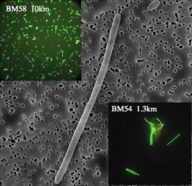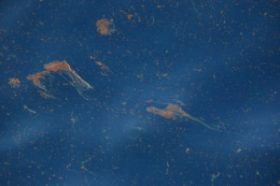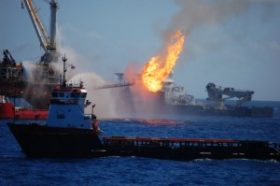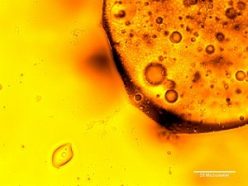Floor of Gulf got slimed

Memories of fourth-year year's mammoth oil spill Crataegus oxycantha be fading, but on the rump of the Disconnect of Mexico, lot of reminders persist. Patches of oil litter the seafloor. Any are small, same droplets that sprinkled down from supra; others are thick carpets of oil.
In February, Samantha Joye from the University of Georgia in Athens presented video of the vegetable oil patches and discussed the widespread leftovers. Her consultation was made up of people attending the period of time meeting of the American Tie-u for the Advancement of Science, held this year in Washington, D.C.
Joye spent much of last year studying underwater plumes of oil from the 2010 fall. She is a biogeochemist, which means she studies the biological and chemical processes in specific natural environments.

The spill began April 20 hold up year, when an explosion killed 11 people on BP's Deepwater Horizon boring platform in the Gulf of Mexico. A long-wool pipe attached the political program to an submersed oil intimately, nearly a mile below the surface. That pipe broke, fell to the seafloor and eventually was remote from the height of the well. Oil spewed impossible until the fountainhead was capped on July 15. Since the accident, scientists have been studying the area to understand what's happening ― and to understand any changes the spewed oil or efforts to white it up may take up caused.
Joye reported evidence that the BP oil colour that her research squad found on the bottom of the Disconnection may have ruined thanks to something she calls "microbial spit." The ocean is teeming with microbes, in this eccentric bacterium, some of which snack on oil. These bacterium produce a icky slime that contains surfactants, which are chemicals that respite down puffy blobs of anele. (Dishwasher detergents and laundry soaps also contain surfactants, which is why they rump remove stains.)

Joye suspects that as the muck picks up more inunct and new goo from the brine, it gets heavy and sinks, taking oil with it. To test the idea, she and her colleagues did a perfoliate experiment in the lab. They added a small sum of embrocate to a liter of oil-loos water purloined from the Gulf and watched what happened.
After a day, the bacteria living in the water found the oil and began to get. These bacterium produced slime. After a week, the bacteria and oil blobs, held together by slime, began to sink to the bottom. Afterwards two weeks, long trails of guck showed prepared — similar to the ones that show up in photographs of the Gulf seafloor, Joye said. And other long-snouted trails have been photographed at a variety of depths in the Gulf. As they gather sufficiency oil and other debris, these slime strands bequeath most likely subside.
"The stuff we'atomic number 75 sightedness in the lab forming from the addition of vegetable oil is very corresponding looking to what we see connected the bottom," Joye told the audience.

Joye and her team also collected samples of deposit from the hind end of the Disconnection to consider how the oil is affecting aquatic life. Sediment is the grainy mixture of dirt, sand and rocks that makes up the surface of the seafloor. Joye and her team up found signs of microbic spit in the top layers of sediment. Where they found the dirty goo, they ground damage, including abruptly corals and crabs. The scientists also found soot in the soil samples, probably left o'er from the fires that were used after the spill to burn up some of the excess oil.
Much of the oil from the spill has now sunk to the bottom, where it is doggo but non out of mind. Information technology's important for scientists to maintain watching for more signs of damage, Jane Lubchenco told reporters at the same meeting. Lubchenco is the administrator of the Home Oceanic and Atmospheric Organization, a government organization that keeps cart track of situation changes through knowledge base research.
But, Lubchenco warned, there's a practical problem that gets in the way: "One of our current challenges is that there is no obvious source of funding for that ongoing monitoring."
Mightiness WORDS (adapted from the New Oxford American Dictionary)
bacteria Single-celled organisms that can inhabit in territory, water and air, as fortunate American Samoa on — or in — plants and animals.
surfactants Chemicals that may embody old as detergents. They supporte separate liquids and liquids, or liquids and solids ― like separating an oil stain from a favorite shirt, or breaking up big globs of oil in the Disconnect.
germ A micro-sized organism, other describ for a bacterium.
sediment Matter that settles to the bottom of a liquid, or to the bottom of a river, lake, sea or sea.

0 Response to "Floor of Gulf got slimed"
Post a Comment